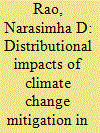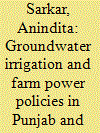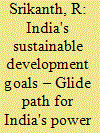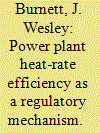|
|
|
Sort Order |
|
|
|
Items / Page
|
|
|
|
|
|
|
| Srl | Item |
| 1 |
ID:
125729


|
|
|
|
|
| Publication |
2013.
|
| Summary/Abstract |
In 2001, Australia introduced legislation requiring investment in new renewable electricity generating capacity. The legislation was significantly expanded in 2009 to give effect to a 20% Renewable Energy Target (RET). Importantly, the policy was introduced with bipartisan support and is consistent with global policy trends. In this article, we examine the history of the policy and establish that the 'stop/start' nature of renewable policy development has resulted in investors withholding new capital until greater certainty is provided. We utilise the methodology from Simshauser and Nelson (2012) to examine whether capital market efficiency losses would occur under certain policy scenarios. The results show that electricity costs would increase by between $51 million and $119 million if the large-scale RET is abandoned even after accounting for avoided renewable costs. Our conclusions are clear: we find that policymakers should be guided by a high level public policy principle in relation to large-scale renewable energy policy: constant review is not reform.
|
|
|
|
|
|
|
|
|
|
|
|
|
|
|
|
| 2 |
ID:
125653


|
|
|
|
|
| Publication |
2013.
|
| Summary/Abstract |
Studies that examine the distributional impacts of climate change mitigation policies often neglect the influence of institutions that implement these policies. This study examines the short-term consumption-side distributional impacts of expanding low-carbon electric supply in the state of Maharashtra, India with a focus on the influence of regulatory discretion in pricing. Households' welfare impacts from economy-wide electricity price shocks are simulated against a baseline that is calibrated to actual household economic and electricity service conditions, including actual electricity budgets, block tier prices and supply rationing. Industrial price impacts are propagated to households using a Leontief input-output analysis. Regulatory pricing decisions are evaluated based on social welfare metrics for economic efficiency and income inequality. The analysis reveals new linkages between climate change mitigation, electricity policy and income distribution. Low-income households can be shielded from mitigation impacts without losses in aggregate welfare to the extent that regulators can recover mitigation costs through industrial price increases. Regulators' flexibility to distribute costs across households is constrained by industrial customers' migration off the grid. Reduced supply interruptions to the rural poor from the resulting demand contraction are a potential co-benefit of mitigation. Distributional impacts, therefore, depend on other electricity policies that are driven by the political economy of the sector.
|
|
|
|
|
|
|
|
|
|
|
|
|
|
|
|
| 3 |
ID:
116945


|
|
|
|
|
| Publication |
2012.
|
| Summary/Abstract |
Due largely to recent dramatic cost reductions, photovoltaics (PVs) are poised to make a significant contribution to electricity supply. In particular, distributed applications of PV on rooftops, brownfields, and other similar applications - hold great technical potential. In order for this potential to be realized, however, PV must be "cost-effective"-that is, it must be sufficiently financially appealing to attract large amounts of investment capital.
Electricity costs for most commercial and industrial end-users come in two forms: consumption (kWh) and demand (kW). Although rates vary, for a typical larger commercial or industrial user, demand charges account for about ~40% of total electricity costs. This paper uses a case study of PV on a large university campus to reveal that even very large PV installations will often provide very small demand reductions. As a result, it will be very difficult for PV to demonstrate cost-effectiveness for large commercial customers, even if PV costs continue to drop. If policymakers would like PV to play a significant role in electricity generation - for economic development, carbon reduction, or other reasons - then rate structures will need significant adjustment, or improved distributed storage technologies will be needed.
|
|
|
|
|
|
|
|
|
|
|
|
|
|
|
|
| 4 |
ID:
166367


|
|
|
|
|
| Summary/Abstract |
This article contributes to the discussion of frameworks for conducting energy policy analysis. The article considers the influence of epistemic frames on energy policy decisions, and particularly the representation of energy problems, using a social constructionist approach and a case study of Australian electricity policy, the cornerstone of the nation's energy policy. Rather than contributing to the debate about the future of a country-specific electricity sector or a classification of differing conceptualisations of energy, the article focuses on 'the explanation of energy’ by investigating the framing of Australian electricity policy from early 20th century Federation to the contemporary era. A six-question analytical grid is deployed to examine how debates and policies about electricity provisioning—and the ‘energy problem’—have been constructed and reconstructed. The article concludes that the framing and reframing of the problem of ‘energy’ over time represents a key mechanism through which the state has represented, constituted and configured its role in the nation and reflects broader transformations in ‘governing’.
|
|
|
|
|
|
|
|
|
|
|
|
|
|
|
|
| 5 |
ID:
176757


|
|
|
|
|
| Summary/Abstract |
This paper presents the contrasting picture of groundwater irrigation, agricultural growth and farm electricity consumption in Punjab and West Bengal. While Punjab, a semi-arid, groundwater depleted state continues to follow water intensive rice-wheat cropping pattern assisted with free farm power since 1997; West Bengal, a groundwater abundant state became the first state to vigorously meter its electric tubewells with a flat-cum-metered tariff since 2011. At present, Punjab aims to reduce subsidies by rationing farm power supply but assists farmers with minimum support price to sustain their farm incomes. West Bengal experienced a major boost in rice cultivation in the eighties with the spread of shallow-tubewells. Contrary to the optimistic predictions of boost in boro rice cultivation with the introduction of liberalised policy of new tubewell permits, Bengal could not unleash the untapped potential of groundwater irrigation. Though the number of tubewells increased manifold, the increasing tariff of volumetric electricity pricing did not lead to any major boost to groundwater irrigation. Bengal the leading rice growing state in India needs an appropriate power policy along with conducive procurement infrastructure so that it can provide better farm incomes to the rice farmers and in the long run can take the pressure off from north western India which is burdened with chronic groundwater depletion on account of intensive rice cultivation.
|
|
|
|
|
|
|
|
|
|
|
|
|
|
|
|
| 6 |
ID:
132665


|
|
|
|
|
| Publication |
2014.
|
| Summary/Abstract |
According to the 2011 Census of India, over 31% of India×s 1.2 billion people lived in nearly 8000 towns and cities; the remaining 830 million people lived in over 638,000 villages. About 55% of rural households and 93% of urban households had access to electricity. The 2005 Indian Human Development Survey showed that on average, electricity availability (hours of supply per day) in rural and urban households were 14 and 19 h, respectively ( Desai et al., 2007). Using nationally representative data from Indian Human Development Survey, this study estimated the impact of electricity access and availability on two attributes of human well-being, viz. education and health attainment. It found a significant positive relationship between electricity availability and well-being in rural and urban households. Electricity accessibility, revealed a significant positive relationship only for rural households. The paper concludes with implications for electricity policy and infrastructure choices.
|
|
|
|
|
|
|
|
|
|
|
|
|
|
|
|
| 7 |
ID:
162307


|
|
|
|
|
| Summary/Abstract |
India has adopted the 2030 Agenda during the United Nations Summit held in September 2015. Energy is intimately connected with 74% of the 169 targets related to the 17 Sustainable Development Goals (SDGs) to be achieved by 2030. Subsequently, India has also submitted its Nationally Determined Contributions (NDCs) for the period 2021–2030 to the United Nations Framework Convention on Climate Change (UNFCCC). While the Government of India (GOI) has ambitious plans for enhancing the installed capacity of RE sources, 75% of its electricity is currently generated by coal-fired power plants. As India's electricity requirements grow to meet the aspirations of 1.3 Bi people, it needs a policy framework that integrates all low-carbon energy technologies with coal in such a manner that the reliability, security, and affordability of electric supply are balanced with sustainable development. India also needs to develop innovative strategies to clean up the country's coal sector while enhancing the integration of renewable energy into the National Power Grid. In this context, certain recommendations are proposed in this article for timely implementation by GOI to facilitate the achievement of India's targets with respect to SDG 7 and the NDCs in an efficient and effective manner.
|
|
|
|
|
|
|
|
|
|
|
|
|
|
|
|
| 8 |
ID:
169744


|
|
|
|
|
| Summary/Abstract |
In August 2018, the U.S. Environmental Protection Agency (EPA) proposed a new policy – the Affordable Clean Energy rule – to reduce greenhouse gas (GHG) emissions from existing coal-fired electric generating units and power plants. The new rule establishes emissions guidelines, including heat-rate efficiency improvements, for states when developing plans to limit GHG emissions. Past studies have indicated that heat-rate efficiency improvements can increase electricity output, leading to a reduction in emissions rates and an increase in emissions levels – a rebound effect that can temper the emissions-reduction benefits of plant-level heat-rate efficiency. This study adds to the literature by examining data on the relationship of plant-level heat-rate efficiency on the rate and level of GHG emissions. We explored three different types of GHGs – carbon dioxide, methane, and nitrous oxide. Controlling for variation across operators, our results suggest that gains in heat-rate efficiency are associated with higher levels of all three pollutants. Specifically, we found that a ten percent increase in heat-rate efficiency led to an average seven-to-nine percent increase in the level of GHG emissions. Our analysis highlights the need to further study the full effects of heat-rate efficiency policies before such rules are enacted.
|
|
|
|
|
|
|
|
|
|
|
|
|
|
|
|
|
|
|
|
|